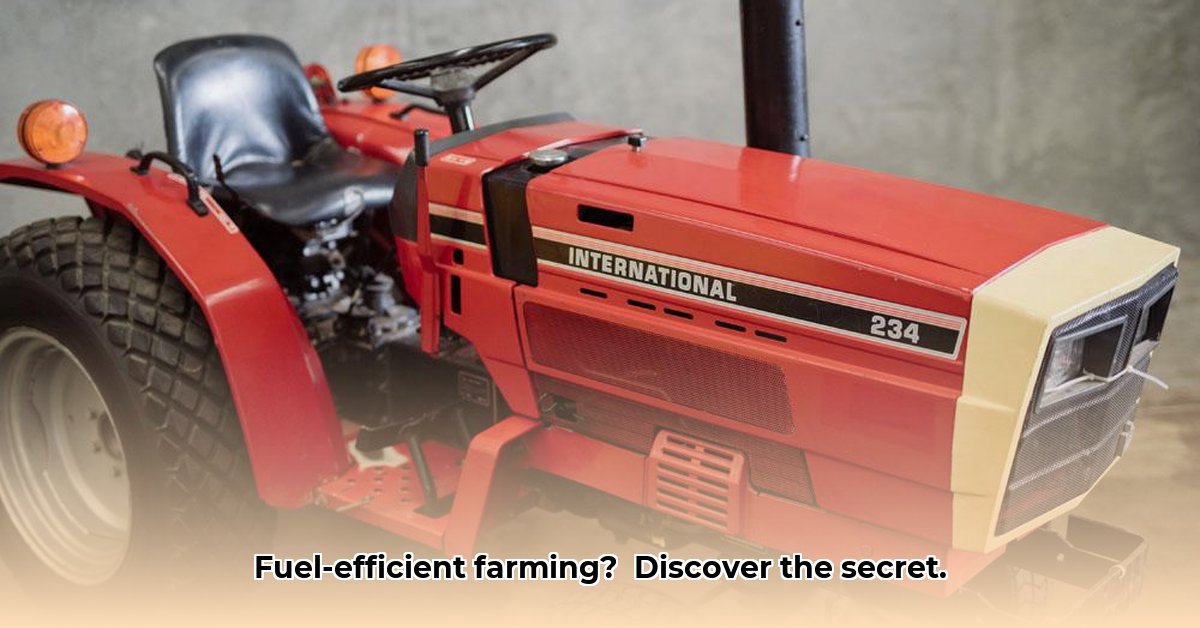
The International 234 diesel tractor, a product of the International Harvester and Mitsubishi collaboration (1982-1985), represents a compelling case study in sustainable agricultural practices. While compact in design, its enduring legacy demonstrates the potential for efficient and environmentally conscious farming, even with older technology. This analysis explores its technical specifications, performance, maintenance, and environmental impact, comparing it to modern alternatives to assess its continuing relevance in sustainable agriculture. For more on modern tractor technology, see this comparison of a John Deere 4WD.
A Closer Look: Specifications and Historical Context
The International 234's compact design, powered by a 0.8-liter, three-cylinder Mitsubishi diesel engine generating approximately 18 horsepower, belied its surprising efficiency. This power-to-weight ratio contributed significantly to its fuel efficiency, a key factor in sustainable farming. The availability of both gear and hydrostatic transmission options provided farmers with adaptability depending on specific tasks. Its design prioritized simplicity, ease of maintenance, and fuel economy— hallmarks of sustainable design philosophies that were just beginning to gain traction during its production years.
Fuel Efficiency: A Benchmark for its Era
Fuel efficiency is paramount in modern sustainable agriculture. While precise fuel consumption data for the IH 234 is scarce, its smaller engine inherently suggests better fuel economy than larger tractors of the same period. The principle of reduced fuel consumption per unit of work remains a critical aspect of sustainable agriculture. How does this compare to modern compact tractors? Further research comparing the IH 234’s fuel consumption per acre tilled to modern models is needed to fully assess its long-term economic and environmental advantages. Wouldn't such data prove invaluable in evaluating the true cost-effectiveness of this vintage tractor against modern alternatives?
Maintenance and Repair: A Test of Time
The simplicity of the IH 234's design translates to relatively straightforward maintenance and repairs. However, the age of the tractor presents challenges. Sourcing replacement parts may prove difficult. This factor needs careful consideration. The longevity and ongoing maintenance costs need to be weighed against any initial cost savings. A cost-benefit analysis considering parts availability, repair expenses, and labor is crucial for a complete sustainability assessment.
Environmental Impact: A Retrospective View
The IH 234's lower fuel consumption, compared to larger tractors of its era, directly translated into lower emissions. However, by today's stringent environmental standards, its emissions would likely not meet current regulations. This highlights the evolution of both technology and environmental consciousness within the agricultural sector. This leads to a vital question: can modifications or alternative fuel sources extend this tractor's sustainable use?
Operational Efficiency: Adaptability and Versatility
The choice between gear and hydrostatic transmission options offered versatility, allowing the IH 234 to adapt to various farming tasks. The gear transmission provided power for heavy-duty operations, while the hydrostatic option facilitated precision tasks. This adaptability directly contributed to its operational efficiency. Did this versatility translate into higher overall productivity per unit of energy consumed, further augmenting its sustainable credentials?
A Legacy of Sustainable Practices
The IH 234’s impact transcends its technical specifications. It played a significant role in the mechanization of smaller farms, illustrating that sustainability and efficiency weren't mutually exclusive concepts, even at a time when those principles weren't widely adopted. It stands as an important historical landmark in the evolution of sustainable agriculture.
Comparative Analysis: The IH 234 versus Modern Compact Tractors
Direct comparison with modern compact tractors is complex. Modern designs incorporate advanced features like electronic fuel injection and optimized engine designs, leading to significantly improved fuel efficiency. However, the initial investment cost and ongoing maintenance of modern tractors need to be factored into any comprehensive cost-benefit comparison. A detailed analysis considering initial cost, fuel consumption per acre worked, maintenance and repair costs, and lifespan would provide a clearer picture of the long-term sustainability of each option.
Key Considerations for a Comprehensive Comparison:
- Obtain precise fuel consumption data: Research original specifications and seek data from owners and online forums.
- Analyze task-based performance: Compare fuel used to perform standard tasks (e.g., plowing an acre) between the IH 234 and comparable modern models.
- Evaluate total cost of ownership: Factor in initial purchase price, fuel, repairs, maintenance, and potential resale value.
This holistic approach provides a more nuanced understanding of the true sustainability of each option, clarifying whether the IH 234's relatively low initial cost and ease of repair outweigh the reduced fuel efficiency and potentially higher long-term maintenance costs compared to modern counterparts.